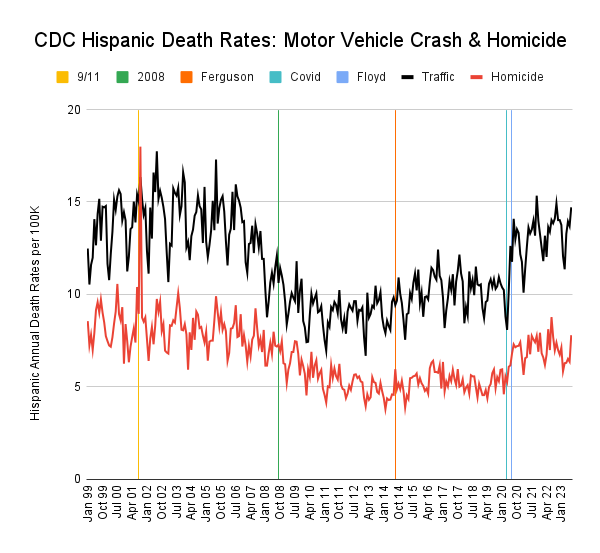
February 14, 2024

Nayib Bukele
Source: Wikimedia Commons
El Salvador president Nayib Bukele was reelected with almost 85 percent of the vote following his massive crackdown on gangs that saw the Central American republic’s official murder rate plummet to historic lows. Bukele’s success raises interesting questions about Latinos’ propensity toward violence.
Unlike in the United States, where the public has to wait almost nine months for national crime statistics to be published, El Salvador’s government announced on Jan. 3, 2024, that only 154 murders had been committed in 2023, down from over 2,000 in 2019.
I’m no expert on which banana republic crime statistics are trustworthy, but by all accounts the murder rate in El Salvador has declined vastly since the middle of the last decade, with the drop beginning even before Bukele was elected in 2019 and then began rounding up men with face tattoos in 2022.
Obviously, much of Bukele’s success is specific to El Salvador’s conditions. Unlike in Mexico, for example, where the cartels contribute to national prosperity by exporting drugs to the United States, El Salvador’s gangs mostly prey on locals through extortion. Thus, they had long worn out whatever popularity they had ever enjoyed amongst the public.
Still, El Salvador is only the most vivid example of what appears to be a general conundrum in both Latin America and among Latinos in the United States: that their levels of criminal violence seem to be highly contingent upon current local politics.
My impression is that Latin crime rates are more the product of social responses to incentives than of sheer knuckleheadedness. Thus, Latin American crime rates can vary greatly across countries and over time, depending upon government policy.
Latin America has had many of the countries with the highest reported homicide rates in the world. For example, El Salvador peaked at over 1 out of every 1,000 people being murdered in 2015, a horrific rate only occasionally reached in the most dangerous cities in the U.S.
One out of a thousand per year sounds insignificant, but multiply it by 80—Latinos tend to be long-lived when they aren’t killing each other—to approximate the lifetime risk of being murdered. And men bear most of the risk, so El Salvador’s 2015 rate pencils out to approaching a 15 percent lifetime risk of a man being murdered.
On the other hand, Latin America also has other poor countries, such as Peru and Bolivia, where the homicide rate is below that of the U.S. as a whole.
And it’s not uncommon for Latin American countries to follow curious paths, such as Ecuador, where the murder rate fell dramatically from 2010 to 2016, before exploding in this decade as Ecuador has taken on a role in the drug trade similar to Pablo Escobar’s Colombia in the 1980s.
And while U.S. murder rates by state, county, and city mostly vary not with the strength of gun control laws on rifle sales at Walmart, as Democrats assume, or whether illegal immigrants are toting backpacks stuffed with fentanyl, as Republicans insist, but, depressingly, with what percentage of the local population is black, there’s some evidence that Hispanic-American crime rates are somewhat amenable to government suasion.
Thus it’s worrisome that during the “racial reckoning” of the 2020s when the Establishment has obsessed over African Americans, Hispanics, after making quite a bit of progress over the previous generation toward greater levels of law-abidingness, appear to have regressed considerably.
Granted, our data on Hispanics—such as how many of them there are in the U.S. (the Census Bureau guesstimates 64 million, but nobody appears to have much of a clue how many illegal aliens are here)—is less than perfect. FBI crime statistics, for instance, are notoriously woozy about splitting out Hispanics from non-Hispanic whites.
Still, the CDC’s WONDER database on causes of death provides fairly reliable-seeming data on two types of deaths that correlate with a lack of law-abidingness—homicides and motor vehicle accidents. Dead bodies demand bureaucratic attention, so studying CDC death rate trends can illuminate current history.
Please note that the following graph counts victimizations rather than perpetrations. That’s why 9/11 shows up as a huge spike in homicides. But with that historic exception, it’s likely that trends in victims and perps are fairly well correlated over time.

It’s not at all well-known that Latino death rates began to plummet in 2007–08 with the popping of the subprime mortgage bubble. It’s naturally assumed that economic hard times lead to increased crime, as in Victor Hugo’s 1862 novel Les Misérables, in which Jean Valjean steals bread to feed his family.
But in recent decades, we instead see that what I call deaths of exuberance, such as shootings and car crashes, tend to fall when cash is tight. One theory for why Hispanic behavior improved so much at the end of the first decade of this century is that many of the most marginal Latinos likely went home when the U.S. economy cratered. But we don’t know that for sure, because we don’t try very hard to know how many Hispanics are in the country. That would be racist.
The Ferguson Effect and an improving economy reversed that trend in 2015–2016, but Hispanic behavior improved again during the first three Trump years.
Then came 2020 and the double whammy of Covid stimulus and the George Floyd racial reckoning against the police driving up car crashes and murders. Hispanics didn’t react as instantly as blacks did to the new incentive structure, but they also kept getting worse into 2022.
Hopefully, 2023 saw an improvement, but the CDC lags homicide and accident data by six months to make sure to get the numbers right, so we currently only have counts up through July 2023. Still, we’ve managed to throw away most of the Hispanic progress of the past fifteen years.
Another curious aspect of Hispanic disorder is that it varies significantly by locale. Here are homicide victimization rates for Hispanics in a selection of larger counties for 2020–22:

Why do Hispanics die by homicide more than five times as often in Albuquerque as in El Paso, 267 miles down the Rio Grande River?
When I first became interested in social science statistics a half century ago, the rule of thumb was that mulatto Puerto Ricans had the highest crime rate, blanco Cubans the lowest, and mestizo Mexicans fell in the middle.
You can see traces of that still in evidence: e.g., Miami has a low murder rate, while Hartford does not.
But several things have changed. For instance, homicides have fallen so much in the New York to Boston region that not all mulatto-dominated counties are all that bad anymore. The South Bronx is now in the middle of the pack.
Today, the mestizo states of New Mexico and Colorado have the worst homicide rates among Hispanics, with mulatto Pennsylvania third. Colorado is generally a thriving place these days, so why are its Hispanics killing each other so much?
James Michener’s 1976 novel Centennial about the history of Colorado cites a dysfunctional aspect of 19th-century Mexican-American culture: A boy had to do two things to prove he was a man—knife any man who attempts to deflower his virgin sister and deflower the virgin sisters of many other men. Not surprisingly, this led to a high murder rate.
But is this cultural norm still operative? Is something else going on in this region? Nobody seems all that interested in finding out.
And yet, El Paso to the south of Albuquerque and Colorado Springs has a low homicide rate. Why? El Paso was a destination for middle-class refugees from the Mexican Revolution 110 years ago, but is that still relevant? Conversely, Time magazine argued in 1971 that El Paso’s low crime rate was due to lithium in the groundwater sedating manic-depressives. Has that idea been vindicated or debunked over the past 53 years?
I wish I had answers to these questions, but I don’t.
But at least I have questions.